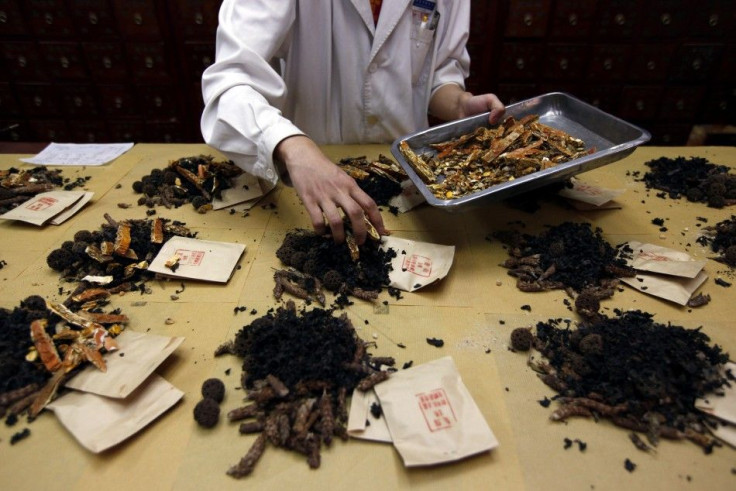Chinese Herb Mix May Shorten Flu Fever

In mild cases of H1N1 influenza, a traditional Chinese herb mixture may relieve a fever about as well as the antiviral drug Tamiflu, researchers reported Monday.
The herb product, called maxingshigan-yinqiaosan, is not widely available on store shelves in western countries.
But in a study of 410 Chinese adults with H1N1 flu (also known as swine flu), those who took the herb mixture typically saw their fevers resolve after 16 hours, versus 26 hours in patients in a "control group" whose only flu treatment was acetaminophen (Tylenol) if their fever passed 102 degrees F.
Patients in a third group received the prescription antiviral drug Tamiflu, known generically as oseltamivir. With Tamiflu, fevers typically resolved after 20 hours, or six hours sooner than in the control group.
A fourth study group received both the herb mix and Tamiflu, with their fevers generally disappearing in 15 hours, according to findings published in the Annals of Internal Medicine.
Exactly what the results mean for flu sufferers around the world is not clear.
The study included only young and middle-aged adults who, other than having a fairly mild case of the flu, were healthy. Tamiflu and another antiviral drug, Relenza (zanamivir), are usually reserved for people with severe cases, or those at high risk of flu complications like pneumonia.
The elderly and people with certain chronic health conditions, like heart or lung disease, are among those at high risk.
It was necessary to first study the effects of maxingshigan-yinqiaosan in low-risk people with milder cases of the flu, said Dr. Lixing Lao, a professor at the University of Maryland School of Medicine in Baltimore who was not involved in the research.
But that's also a limitation of the study, he noted.
"In people with severe illness, this herb may not work. We don't know yet," said Lao, who also directs the traditional Chinese medicine research program at the university's Center for Integrative Medicine.
And for healthy people with mild cases of the flu, there's the question of availability.
The herbs used in the study, which were heated and made into a beverage, have a long history of use in China for colds and flu.
They are also widely available in certain other countries, like Japan, Korea and Germany, according to Drs. Cheng Wang and Bin Cao of the Beijing Institute of Respiratory Medicine, who led the study.
It's possible, the researchers say, that maxingshigan-yinqiaosan could offer a flu-fighting alternative in certain places where Tamiflu is scarce -- like rural China.
But one of the key ingredients is ephedra, or ma huang, which is banned from use in dietary supplements in the U.S. and Canada. Those bans came after ephedra in weight-loss and body-building supplements was linked to heart attacks, strokes and deaths in some users.
That ban did not apply to ephedra's use in Chinese medicine, where small doses are mixed with other traditional herbs -- in contrast to the single, higher doses used in the banned supplements.
However, Americans cannot go to their local store and pull maxingshigan-yinqiaosan off the shelf. They would need to go to a traditional Chinese medicine practitioner, Lao said.
Properly using the right mix of herbs, he said, "requires some knowledge."
Lao said he was happy to see that a prestigious medical journal published a study on a traditional Chinese remedy as it is actually practiced -- combining small doses of different herbs.
"If you only look at one herb, it may not work," Lao told Reuters Health.
He also pointed out that the small herb doses used in practice limit the risk of side effects.
In this study, two of the 103 patients who used maxingshigan-yinqiaosan alone developed nausea and vomiting. There were no side effects reported in the other three study groups.
The H1N1 swine flu broke out in 2009 and quickly spread around the world, killing more than 18,000 people, according to the World Health Organization (WHO).
The WHO declared the H1N1 flu pandemic over in August of last year, but H1N1 has now taken over as the main seasonal flu strain in circulation around the world.
The U.S. Centers for Disease Control and Prevention (CDC) recommends Tamiflu and Relenza for treating the flu in people who are very sick or at high risk of complications.
But in general, the agency says, flu sufferers who are otherwise healthy do not need the drugs. They can recover by getting plenty of rest and fluids, and using over-the-counter remedies like acetaminophen for fever.
According to Lao, the current findings are a "good first step" in showing through a controlled clinical trial that traditional Chinese herbs may also battle flu symptoms.
The CDC stresses, however, that the best defense against the flu is the flu vaccine. Experts recommend that everyone older than six months receive a yearly flu shot, which now includes a vaccine against H1N1.
SOURCE: bit.ly/lKiQRq Annals of Internal Medicine, August 16, 2011.
© Copyright Thomson Reuters 2024. All rights reserved.





















